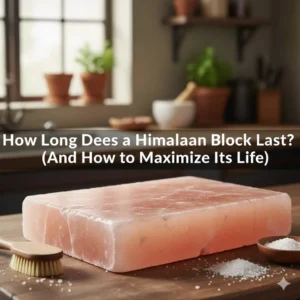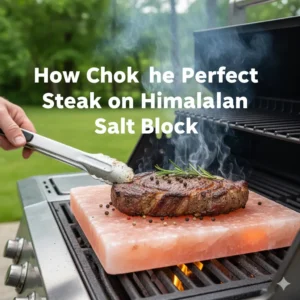Himalayan salt products come in many forms, but two of the most common—salt lamps and cooking blocks—serve entirely different purposes. Both originate from the same natural pink salt deposits, yet one is designed for gentle illumination while the other is engineered for direct contact with food. Understanding these distinctions helps you use each product safely and effectively. This article outlines their key differences, practical uses, and why cooking on a salt lamp can be hazardous.
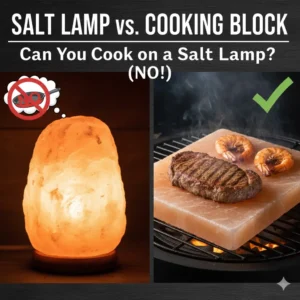
Salt Lamp vs. Cooking Block: Core Differences at a Glance
Both products originate from Himalayan salt, yet their uses differ entirely. The comparison below outlines key contrasts in safety, design, and functionality to help you identify which option aligns best with your intended use.
| Feature | Salt Lamp | Cooking Block |
|---|---|---|
| Primary Use | Decorative lighting and ambiance enhancement | Cooking surface and food presentation |
| Design | Hollowed pink salt crystal containing an internal light bulb | Solid, food-grade salt slab cut for culinary use |
| Heat Resistance | Not suitable for exposure to high temperatures | Engineered to withstand direct heat for cooking |
| Purity Level | Contains natural impurities; not food-grade | Certified food-grade with verified purity |
| Weight | Lightweight and more fragile | Denser and durable for frequent kitchen use |
| Maintenance | Wipe gently to prevent moisture buildup | Requires proper heating and dry storage care |
What Is a Himalayan Salt Lamp?
A Himalayan salt lamp is a decorative item carved from natural pink Himalayan salt, typically sourced from the Khewra Salt Mine in Pakistan. It’s prized for the soft amber light it emits, creating a calm, inviting atmosphere in homes and offices. Although often marketed for potential wellness benefits, its true value lies in aesthetics rather than therapeutic effect.
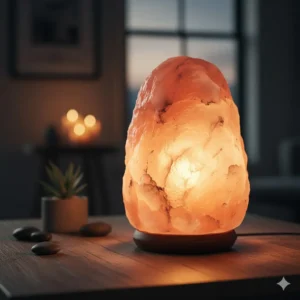
Salt Lamp Characteristics and Benefits
Each lamp is a hollowed-out salt crystal fitted with a small internal bulb that reveals the natural color variations of the rock. The result is a gentle, ambient glow that enriches interior spaces with a sense of warmth and organic texture. Many users choose salt lamps for their distinctive appearance and soothing lighting, rather than for functional illumination.
Some advocates claim that salt lamps emit negative ions that could purify air or enhance mood, but these effects remain scientifically unverified. Nonetheless, their calming light and natural mineral aesthetic make them a preferred decorative accent in tranquil, low-light settings such as bedrooms, studios, or spas.
What Is a Himalayan Salt Cooking Block?
A Himalayan salt cooking block is a solid slab of pink Himalayan salt carved and certified specifically for culinary use. Unlike decorative salt lamps designed for light diffusion, these blocks are food-grade. Their purity and density are verified to ensure no impurities or contaminants transfer to food during heating or serving.
In both professional and home kitchens, salt blocks are prized for their ability to retain and evenly distribute heat. When properly tempered, they’re suitable for grilling, searing, or chilling dishes while imparting subtle seasoning from naturally occurring minerals. This combination of aesthetic appeal and thermal performance makes them a preferred choice among chefs seeking both flavor enhancement and refined presentation.
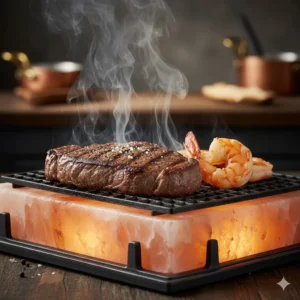
Cooking Block Features and Applications
Each cooking block is precision-cut from dense Himalayan salt formed through ancient mineral deposits free from modern pollutants. Its certified composition allows safe, direct contact with food, setting it apart from decorative lamps not intended for heat exposure or consumption.
- Crafted from solid, food-grade Himalayan salt suitable for direct food contact.
- Used on grills, stovetops, or counters for cooking, grilling, chilling, and presentation.
- Built to endure high temperatures without cracking or releasing unwanted residues.
- Favored in gourmet and hospitality settings for enhancing flavor and plate aesthetics.
Cooking on a Himalayan salt block delivers both performance and presentation. Whether preparing seafood, meat, or vegetables, it allows natural seasoning and heat management that elevate culinary results. This balance of practicality and elegance underscores why the cooking block serves a distinctly different purpose from the decorative salt lamp.
Premium Himalayan Salt Blocks for B2B Partners
Enhance your product line with food-grade pink Himalayan salt blocks sourced directly from the Khewra Salt Mine. Customize sizes, shapes, and packaging with flexible order quantities and global shipping—ideal for food service, retail, and hospitality sectors.
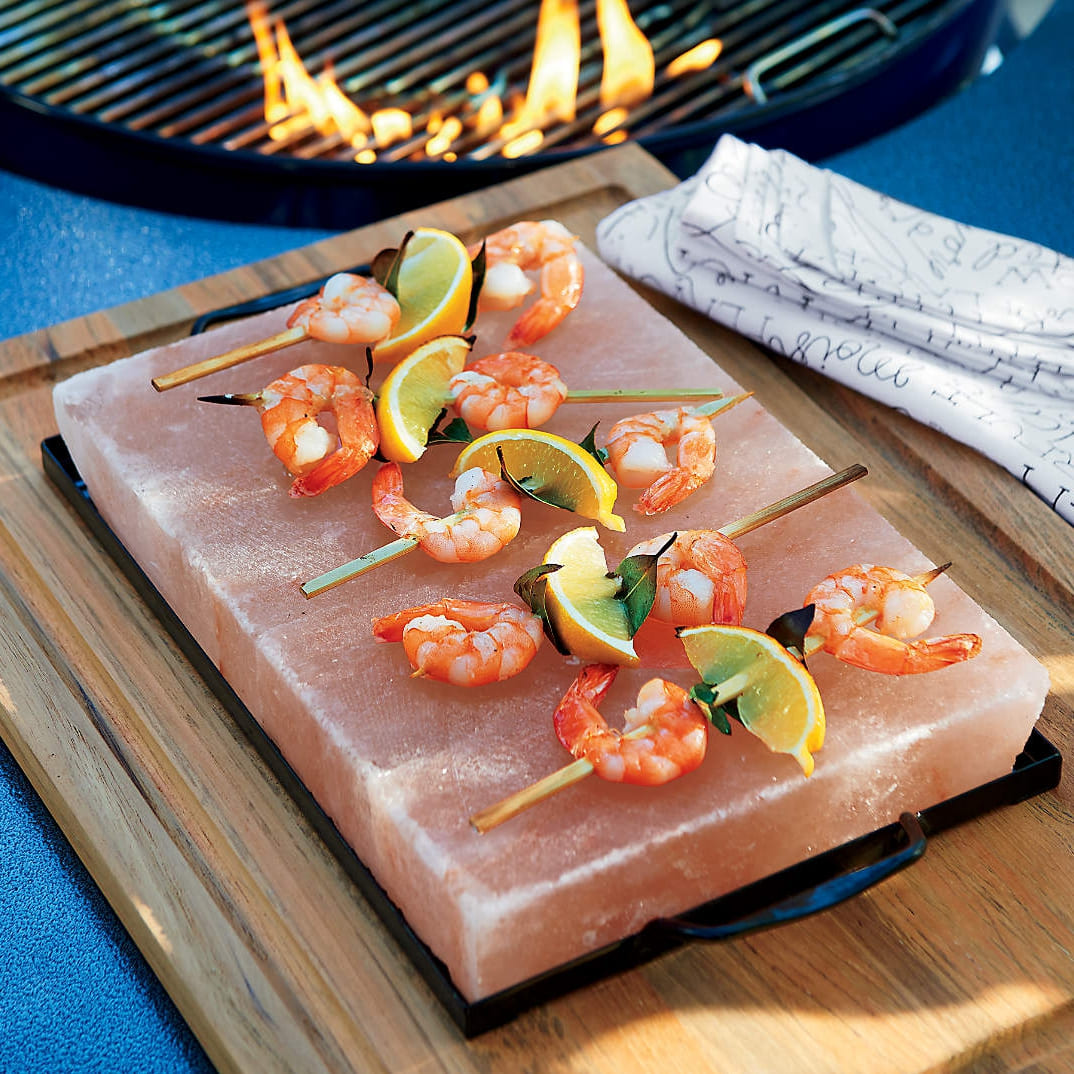
Head-to-Head Comparison: Salt Lamp vs. Cooking Block
Performance and Safety
Though both originate from Himalayan salt, their functional design and safety profiles differ entirely. A salt lamp is engineered for light diffusion, not heat conduction. Its hollow interior accommodates a bulb, rendering it delicate and unsuited for high temperatures. Heating or cooking on one can lead to cracking or breakage, creating significant safety risks.
A cooking block, by contrast, is a solid, food-grade slab specifically crafted for thermal endurance. It remains stable when used on grills, stoves, or in ovens. Certified for culinary use, it does not release contaminants when exposed to heat. This structural integrity and purity make cooking blocks safe and dependable in kitchen environments, while salt lamps remain confined to decorative roles.
Pricing and Value
Salt lamps are typically more cost-effective. Their decorative function, lightweight design, and simple wiring contribute to lower production costs. Because internal fissures or mineral inconsistencies don’t affect lighting performance, quality specifications are less stringent during manufacturing.
Cooking blocks require more rigorous testing to ensure freedom from impurities and structural flaws that could compromise food safety. Their higher purity and heat-resistant density justify a greater price point. Investing in a verified food-grade salt block offers long-term value by ensuring safe use and avoiding potential damage or contamination from non-culinary alternatives. The choice ultimately depends on whether you prioritize aesthetic ambiance or functional cooking performance.
Core Features and Benefits
Salt lamps enrich interiors with a warm, amber glow and a tranquil visual effect. While some users associate them with air-refreshing qualities, their primary contribution is atmospheric design. They should be positioned away from moisture and cooking areas to prevent surface degradation.
Cooking blocks deliver functionality rooted in temperature control rather than illumination. They can be chilled for presenting sushi or desserts, or heated for searing meats and vegetables. This versatility provides a natural seasoning effect that subtly enhances flavor. With proper care—gradual heating, gentle cleaning, and dry storage—a quality block maintains performance and appearance for years. Selecting between the two depends on your goal: ambient lighting or authentic, mineral-infused cooking.
Why You Should Never Cook on a Salt Lamp
Though Himalayan salt lamps and cooking blocks originate from the same natural source, they are engineered for entirely different purposes. A salt lamp is a decorative lighting piece made from a hollowed block of salt with a bulb inside. It is not certified or structurally capable of handling direct heat or food contact.
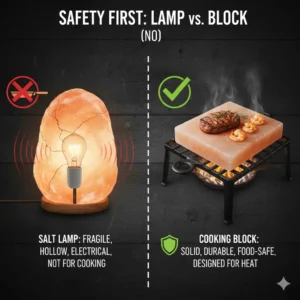
Salt lamps often contain natural fissures and mineral impurities that make them unstable under high temperatures. When exposed to heat, these flaws can cause cracking or even minor breakage, while the hollow cavity that holds the bulb further weakens the structure—creating serious safety risks if used for cooking or grilling.
Heating a salt lamp can also release non–food-safe residues and, if still assembled, increase the risk of fire or electrical damage. By contrast, Himalayan salt cooking blocks are solid, food-grade slabs tested for purity and density, specifically built to withstand heat safely while providing a clean, mineral-rich cooking surface.
Frequently Asked Questions About Himalayan Salt Lamps and Blocks
What happens if you heat a salt lamp?
Applying heat to a salt lamp can cause it to crack or even break apart due to internal fissures and uneven mineral density. These lamps are not designed for cooking temperatures, and sudden exposure to heat can make them unstable and unsafe. Use them strictly for ambient lighting.
Are salt lamps and cooking blocks made from the same type of salt?
Both originate from Himalayan pink salt, but they undergo different processing. Cooking blocks are selected and refined to meet food-grade standards, ensuring safe contact with food, while salt lamps are crafted for aesthetic purposes where purity and structural integrity are secondary concerns.
Why are salt lamps not considered food-safe?
Salt lamps are not food-grade because they may contain impurities and microfractures that can release contaminants when heated. They are not certified for direct food contact and should never be used for cooking or food presentation.
Can a broken cooking block be reused as a candle holder?
Yes, a smooth and stable piece of a broken cooking block can be repurposed as a candle holder if the edges are polished and the surface is even. Ensure it is completely dry and placed on a heat-resistant base to prevent cracking or moisture absorption.
How can I confirm that a salt block is food-grade?
Check the product labeling for terms like “food-grade” or “safe for cooking and serving.” Trusted suppliers provide origin details and purity certifications verifying that the block meets hygiene and safety standards for culinary use.
Final Thoughts
Although Himalayan salt lamps and cooking blocks share a similar appearance, they fulfill entirely different roles. A salt lamp enhances ambience with its soft glow, while a cooking block is a food-grade utensil engineered to withstand heat for safe culinary use.
Selecting the right option depends on your primary objective. If the goal is interior atmosphere, a lamp offers aesthetic warmth. For cooking or serving, only certified food-grade salt blocks ensure safety and performance.
Always align usage with purpose—use food-grade salt blocks for meal preparation and reserve decorative salt lamps for lighting. Never use a salt lamp for cooking under any circumstance.




